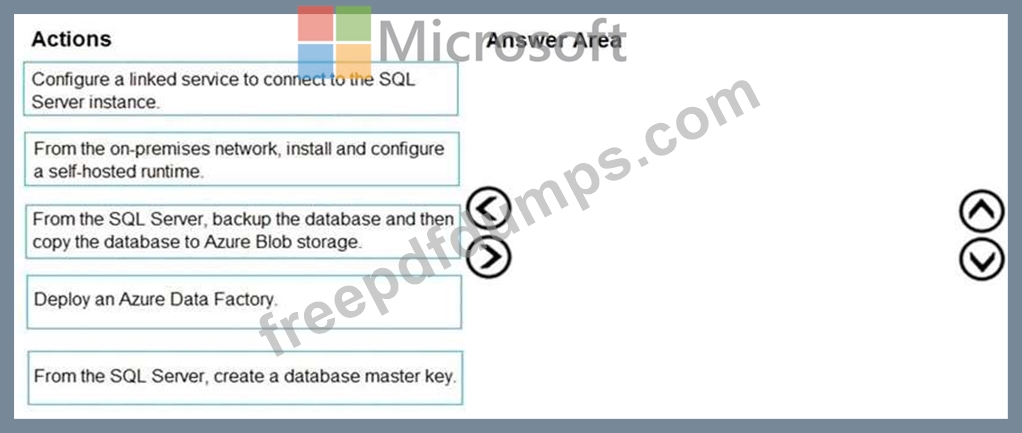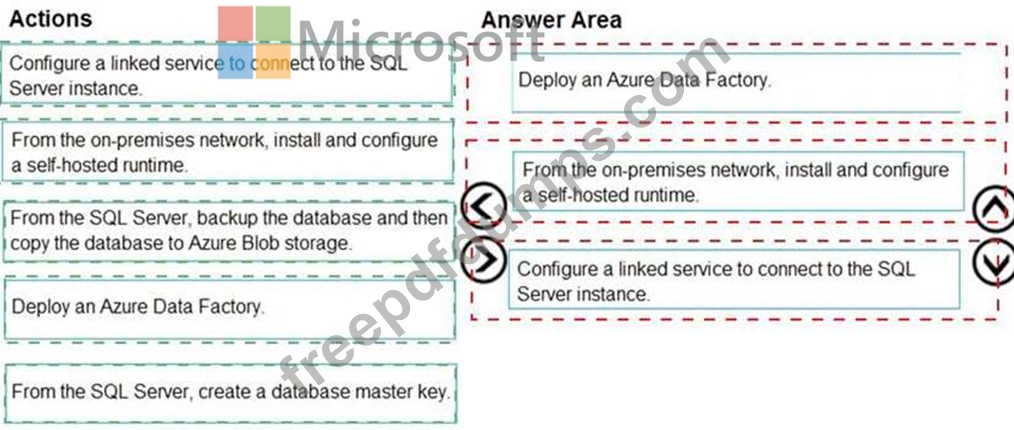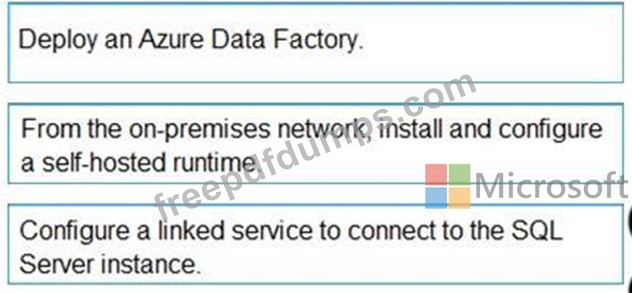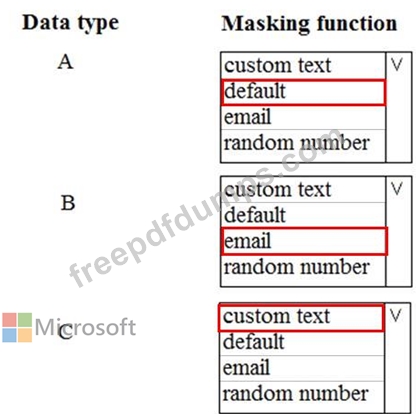DP-200 Exam Question 101
Your company has on-premises Microsoft SQL Server instance.
The data engineering team plans to implement a process that copies data from the SQL Server instance to Azure Blob storage. The process must orchestrate and manage the data lifecycle.
You need to configure Azure Data Factory to connect to the SQL Server instance.
Which three actions should you perform in sequence? To answer, move the appropriate actions from the list of actions to the answer area and arrange them in the correct order.

The data engineering team plans to implement a process that copies data from the SQL Server instance to Azure Blob storage. The process must orchestrate and manage the data lifecycle.
You need to configure Azure Data Factory to connect to the SQL Server instance.
Which three actions should you perform in sequence? To answer, move the appropriate actions from the list of actions to the answer area and arrange them in the correct order.

DP-200 Exam Question 102
Note: This question is a part of series of questions that present the same scenario. Each question in the series contains a unique solution. Determine whether the solution meets the stated goals.
You develop a data ingestion process that will import data to an enterprise data warehouse in Azure Synapse Analytics. The data to be ingested resides in parquet files stored in an Azure Data Lake Gen 2 storage account.
You need to load the data from the Azure Data Lake Gen 2 storage account into the Data Warehouse.
Solution:
1. Use Azure Data Factory to convert the parquet files to CSV files
2. Create an external data source pointing to the Azure storage account
3. Create an external file format and external table using the external data source
4. Load the data using the INSERT...SELECTstatement
Does the solution meet the goal?
You develop a data ingestion process that will import data to an enterprise data warehouse in Azure Synapse Analytics. The data to be ingested resides in parquet files stored in an Azure Data Lake Gen 2 storage account.
You need to load the data from the Azure Data Lake Gen 2 storage account into the Data Warehouse.
Solution:
1. Use Azure Data Factory to convert the parquet files to CSV files
2. Create an external data source pointing to the Azure storage account
3. Create an external file format and external table using the external data source
4. Load the data using the INSERT...SELECTstatement
Does the solution meet the goal?
DP-200 Exam Question 103
Which two metrics should you use to identify the appropriate RU/s for the telemetry data? Each correct answer presents part of the solution.
NOTE: Each correct selection is worth one point.
NOTE: Each correct selection is worth one point.
DP-200 Exam Question 104
You need to mask tier 1 dat
a. Which functions should you use? To answer, select the appropriate option in the answer area.
NOTE: Each correct selection is worth one point.

a. Which functions should you use? To answer, select the appropriate option in the answer area.
NOTE: Each correct selection is worth one point.

DP-200 Exam Question 105
Note: This question is part of a series of questions that present the same scenario. Each question in the series contains a unique solution that might meet the stated goals. Some question sets might have more than one correct solution, while others might not have a correct solution.
After you answer a question in this section, you will NOT be able to return to it. As a result, these questions will not appear in the review screen.
You have an Azure subscription that contains an Azure Storage account.
You plan to implement changes to a data storage solution to meet regulatory and compliance standards.
Every day, Azure needs to identify and delete blobs that were NOT modified during the last 100 days.
Solution: You apply an Azure policy that tags the storage account.
Does this meet the goal?
After you answer a question in this section, you will NOT be able to return to it. As a result, these questions will not appear in the review screen.
You have an Azure subscription that contains an Azure Storage account.
You plan to implement changes to a data storage solution to meet regulatory and compliance standards.
Every day, Azure needs to identify and delete blobs that were NOT modified during the last 100 days.
Solution: You apply an Azure policy that tags the storage account.
Does this meet the goal?




